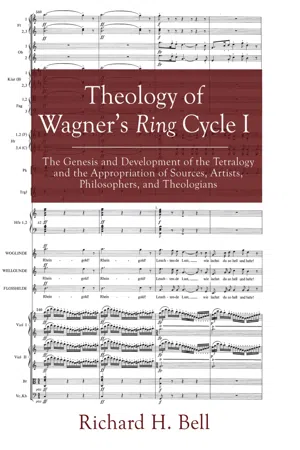![]()
1
Introduction
Scope and Significance of the Ring
Dawson-Bowling is not alone in making this sort of comment on Wagner’s Der Ring des Nibelungen (The Ring of the Nibelung): “[i]n its scope and its reach, in its grandeur of conception and abundance of episode, in its universal relevance and its richness of suggestion [. . .] it has no near rival anywhere in art.” Even if one does not share such an assessment of the tetralogy one can make the simple point that of works regularly performed, the Ring is the longest work of Western classical music, lasting around fourteen to fifteen hours. Derek Cooke writes that the poem of the Ring “still stands as the most prodigious ‘opera libretto’ ever written.” He continues: “It compresses into thirty-seven scenes, with the most decisive dramatic clarity and point, a story of phenomenal intricacy, involving thirty-four characters, sixteen of them main ones, each of whom has a sharply defined individuality [. . .].” This poem is then “married” to highly complex music, the orchestration alone being the most sophisticated up until that time. Even if one does not like Wagner’s Ring (and there are great musicians who do not like it) its creation must nevertheless be considered a consummate achievement.
My own view is that the Ring is one of the greatest of all artworks of Western civilization and is certainly one of the most comprehensive in what it attempts to achieve. It addresses the fundamental concerns that have faced humanity down the millennia, such as power and violence, love and death, freedom and fate. The work, despite being set in what sometimes appears to be medieval times, is remarkably modern and has the capacity to address a whole gamut of issues from capitalism and the ecological crisis through to issues of gender and sexual ethics. It is understandable that Wagner took great pride in his Ring, presenting as it does a vast canvas of mythicized world history. He began work on the libretto in Autumn 1848 and when it was completed at the end of 1852 he had fifty copies privately published, one of which he sent to Franz Liszt on 11 February 1853, enclosing a letter in which he wrote: “Mark my new poem—it contains the world’s beginning and its end!” Three months earlier he wrote in a letter to Uhlig (18 November 1852), as he was completing the libretto: “The whole thing will then be—out with it! I am shameless enough to admit it!—the greatest poem I have ever written.” He then had the Herculean task of setting this to music, this being completed as late as November 1874.
Studying the Theology of the Ring
The artwork of four operas Das Rheingold (The Rhinegold), Die Walküre (The Valkyrie), Siegfried, and Götterdämmerung (Twilight of the Gods) is based on Norse and Germanic mythology and epic which has been radically modified in the light of Greek epic, lyric, and tragedy, and a case can be made that Wagner appropriated this Greek tradition through the lens of Hegel. In the Ring we appear to be dealing with inner worldly events, beginning as it does with a remarkable representation of the evolution of the natural order, moving then to the birth of consciousness, then to the “fall” of humankind through the theft of the Rhinegold. The cycle finally culminates in the death of the heroic couple Siegfried and Brünnhilde which is followed by the death of the gods as their heavenly abode, Valhalla, is engulfed in flames. But although the work appears to be dealing with “inner-worldly events,” it is, as in all myth, attempting to point beyond this world. As Bultmann wrote: “Mythology is the use of imagery to express the other worldly in terms of this world and the divine in terms of human life, the other side in terms of this side.”
To some extent my interests in this work parallel what I attempted in my 2013 study Parsifal, which involved a theological appreciation of the artwork in the light of the composer’s intellectual development. However, the Ring will pose some special challenges for Christian theology since it lacks the clear Christian symbolism found in Parsifal (e.g., the “...
